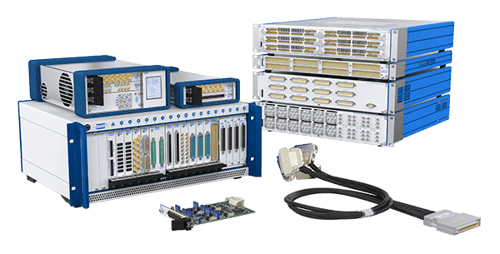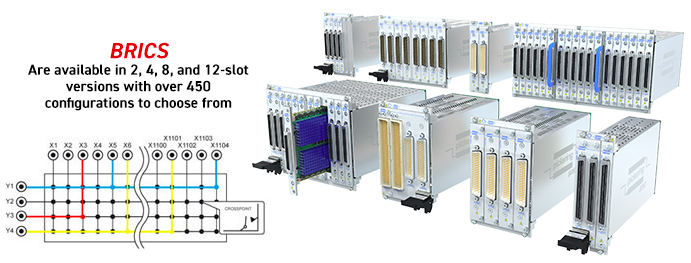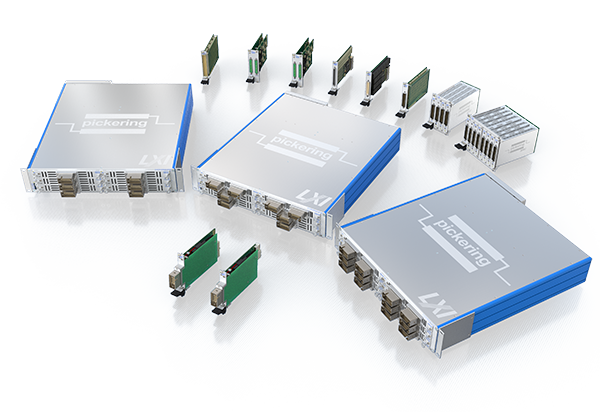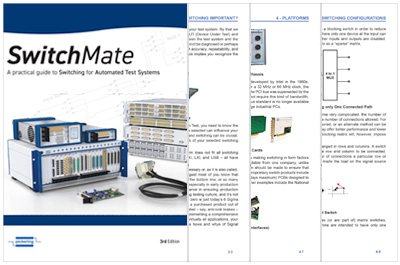What is the Right Platform for My Automated Test System Switching?
When it comes to switching for an automated test system, there are many choices. Vendor, specifications, cable types, switching routing software, etc. One choice often overlooked is the platform the switching should be based on. The test engineer is likely basing their switching choices on the instrumentation. So, if the instrumentation is, for example, PXI, the obvious choice for switching is PXI, right? Well, not necessarily. After all, PXI is an excellent choice for switching with all the market choices. But depending on the application, you should look at other platforms to make your development easier. This post will look at PXI and LXI and highlight reasons to choose either platform or perhaps both.

There has been speculation that PXI and LXI are competing standards, a view that Pickering does not share. The formats are sufficiently different such that there will often be clear cases where one is better for a particular solution than another, and this is particularly true when considering switching platforms.
The following table illustrates examples of these differences, the relevance of any one factor in this table is somewhat dependent on what product the user/vendor wants to create.
| PXI | LXI | |
| Power | Central | AC/DC to each box |
| Programming | Register-based IVI Driver/API |
Message-based (mainly with its own built-in controller) IVI Driver/API |
| Controller | PC-based | Agnostic |
| Operating system | Windows (mainly) | Agnostic |
| Hot swapping or adding modules | Not supported; addition requires restarting the system | Supported |
| Web interface | Not supported | Supported |
| Mechanical size | 3U or 6U Defined depth Small PCB area |
Not constrained, vendor-defined (expect half and full rack width, various heights and depths) |
| Multi-vendor | At module level |
At chassis/box level only |
| Bus interface | PCI and/or PCIe-based, PC controller centric |
Ethernet |
| Trigger | Hardware backplane connection or software through controller |
External cable wired trigger IEEE1588-based event timing Peer-to-peer triggering Proprietary triggering |
As ever, one standard does not fit all — LXI offers the greatest freedom of design, while PXI provides a means to integrate small modules into an open standard chassis. Unsurprisingly, that means both have their place, and both standards can claim circumstances under which they might perform better than the other for switching.
Size Does Matter
There is a clear distinction based on size. For example, if a large, structured RF matrix is required, LXI will often be the better choice because LXI has limited or no mechanical specifications. An LXI switching system can be as big or as compact as necessary and be a fixed configuration or even modular. Because of PXI’s fixed mechanical specifications, there are limitations. PXI can be used to implement virtually all of these large systems. Still, the chassis size and quantity, the number of cable interconnects, and the software complication of implementing a large switching function over many modules increases the system cost, decreases its performance and adds complexity to the system design and programming time.
In PXI, some of these issues can be partly addressed by using switching modules that extend over more than one chassis slot, an example being our “BRIC” high-density switch subsystems first introduced in 2002. These products integrate the switching function over 2, 4, 8 or more PXI slots using only one control connection to the chassis backplane and then use their own internal integrated analog buses to provide connectivity between the switching sub-assemblies in the BRIC housing. This reduces cabling and interfacing costs, simplifies programming and makes a PXI switching solution much more competitive, though LXI platforms still have the edge for extensive switching systems. Internal isolation relays between BRIC sub-assemblies allow the matrix to perform better in many situations.

Pickering PXI switch modules do not have to be confined to PXI chassis for users with diverse switching needs. PXI designs may be the perfect answer, but test engineers do not necessarily want to spread their computer PCI bus over additional external chassis for applications requiring many instruments and switching modules. They also may need to have a longer distance between the controller and the switching or may simply want to get a more web-like feel to the system for remote access or have the ability to make changes without powering down the entire system. For these applications, we have a series of LXI chassis that accept our PXI switch modules. These chassis range from 2-slot ½ rack, 1U chassis to 18-slot full rack 4U, offering a truly versatile platform that can scale up or down in the future as required by the application and allowing system architects the ability to incorporate precisely the switching they need in a system design.
It is important to note that these Pickering LXI chassis accept only Pickering PXI modules as the LXI controller is a Pickering Linux-based design for a cost-effective solution. The same controller brings the user the benefit of all the features of Ethernet connectivity, including web-based management and control of the PXI switching modules, at a very reasonable cost.
High Voltage or Electrical Noise
If your application is switching very high voltages in PXI – up to 9,000 volts at the time of publication – you may want to consider using the LXI platform for two reasons. First, there is potential for electrical noise in the PXI chassis that could compromise your measurements. Second, Ethernet’s transformer-coupled architecture can protect the instrumentation should something go wrong with the signals being switched.

Conclusion
As noted here, different applications may call for different solutions, especially in switching. If your test requirements are for a small channel count of low to medium current requirements, PXI is likely the best choice. But if I/O counts are large or the frequencies and/or voltages get dangerously high, consider a separate LXI chassis.
For more information about the different switching platforms and what one is best to use in your automated test system, take a look at chapter 4 of our SwitchMate book, a practical guide to switching for automated test systems (available as an ebook or you can request a hard copy).
We also have individual publications on PXI - our PXImate book and LXI - our LXImate book.

